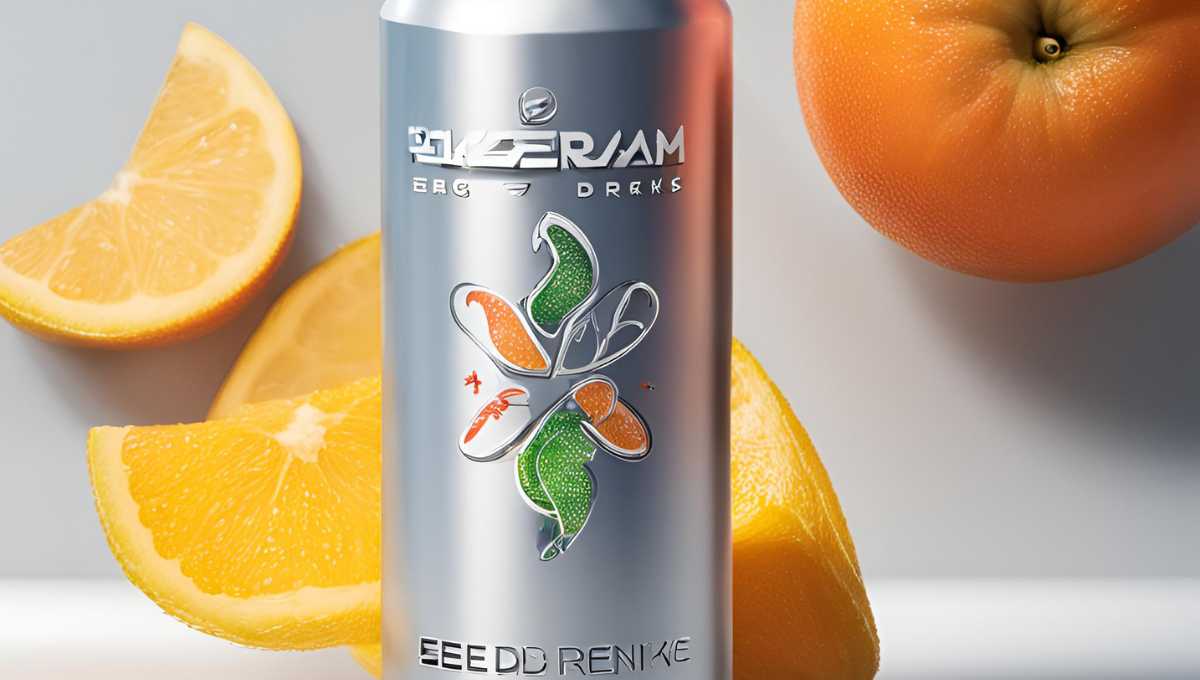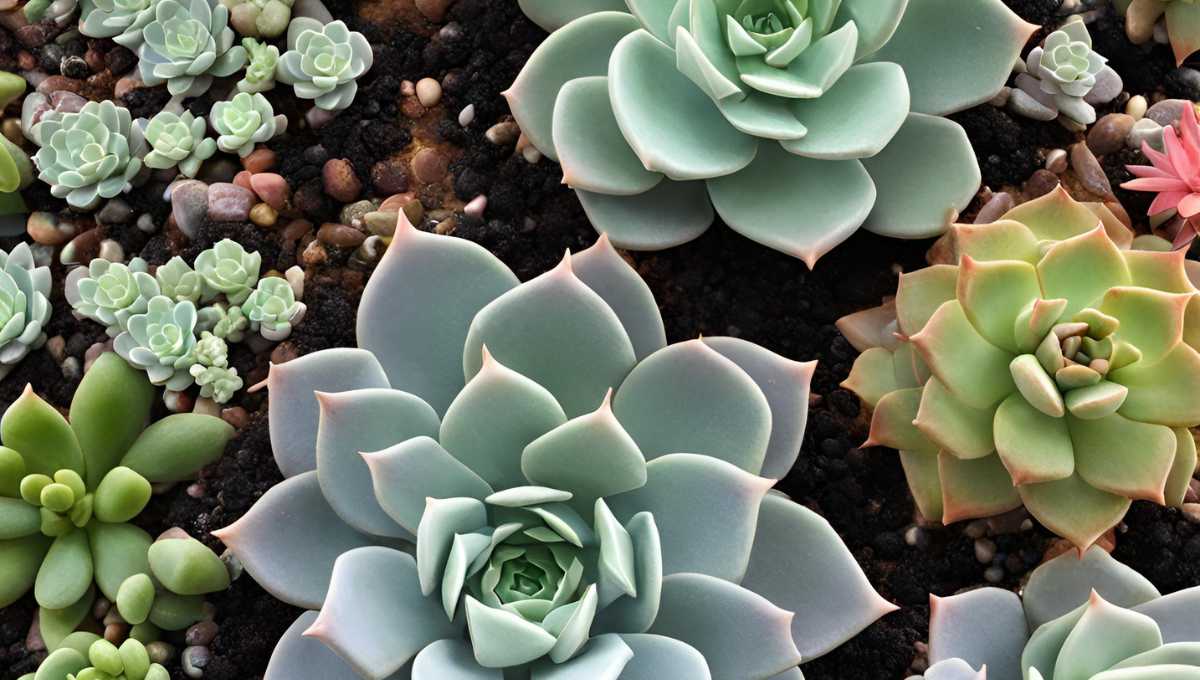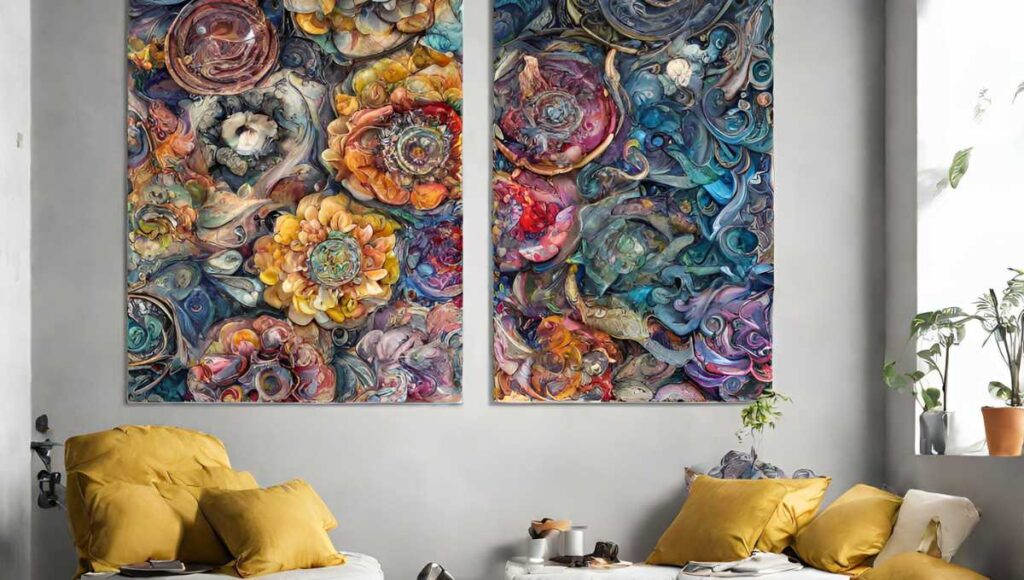
Introduction
Changing up art is such an easy way to change up the mood and personality in your space.but it can get a little bit expensive. So today, we are making high-end wall art that is super affordable.
First project
Require a canvas
And this first project is going to require a canvas. This is a 16 by 20-inch canvas, and I’m going to do something fun and textural with it. And that’s going to require something that I should have had already here.
In This Post
ToggleRequire macrame cord
That’s going to require a macramé cord. We’re going to use some of this for the project. I definitely don’t need as much as I have right here.
Starting a wall art project step by step
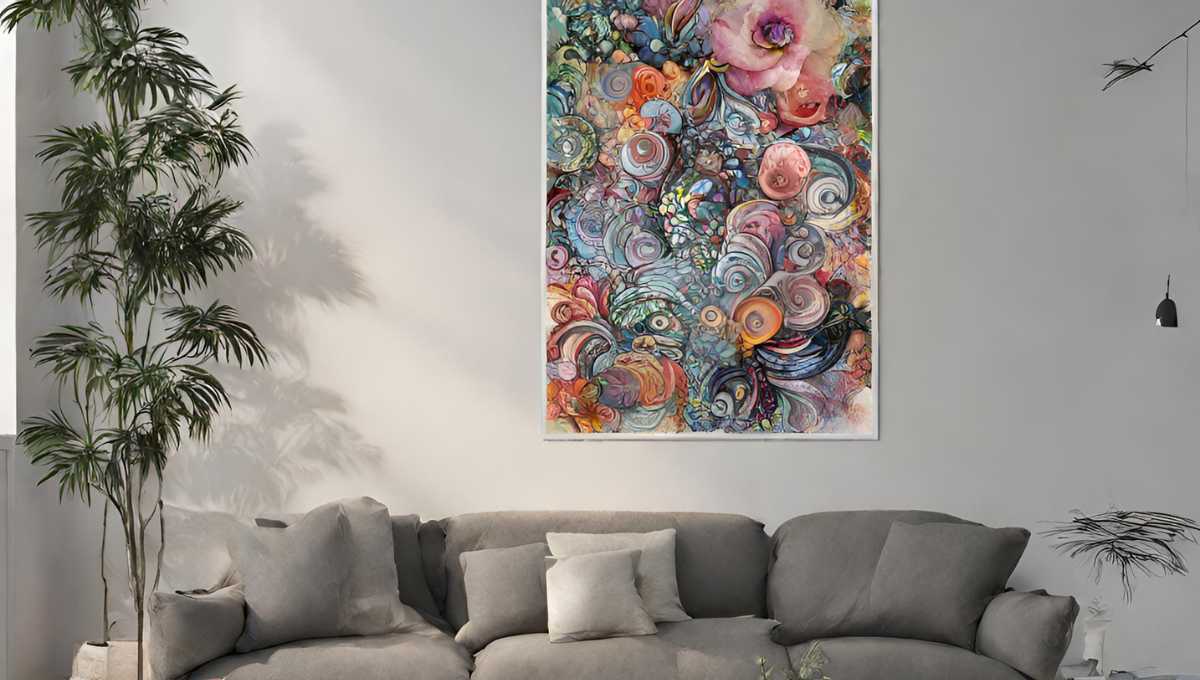
At first i am going to do
- I started by dividing the canvas into two sections.
- The top would be two-thirds.
- and then a bottom third that I left a little bit smaller.
- Then I’m going in with some hot glue and that macramé cord to create a kind of endless rectangle-type pattern.
- I also found that you got the best look by placing the macramé cord a little bit closer together in the narrower parts of the rectangle and then a little bit further apart on the wider ends of the rectangle.
- I am drawing inspiration from a photo I saw right here on Pinterest.
- When I was done with that top rectangle.
- I kind of just left that tail there.
- You’ll see what we’re doing with it in a little bit.
- Then I repeated that same process with the bottom section.
- I did start the tail opposite of how I started the tail on the bigger section.
- and I just wrapped that all the way around until I filled in this bottom third.
- Then, to complete the piece.
- I made it almost look like I did an entire thing with one endless piece of string.
- I took the two tails and matched them up on the side right here.
- and it worked out really well.
- I think this is just a small little detail that I didn’t intentionally think I was going to end up with.
- but I think it really elevates the look of the piece.
- With all of these strings applied to the canvas.
- I am really loving the pattern, but of course, this doesn’t look very cute at this point.
And then
- So to mesh everything together on the canvas.
- I’m going to use a combination of some tissue paper and some Mod Podge to add a layer over the entire thing just to smooth things out and add just an additional level of texture.
- I really think this is going to make all of the difference for this piece.
- Now, when adding that tissue paper with the Mod Podge.
- I did find it took a little bit of trial and error until I figured out the best way to apply it because there were all of those textured areas from the rope.
- I found what worked best was putting the glue down onto the canvas and onto the rope and then placing the tissue paper sheet by working it in.
- starting at the center of the tissue paper piece.
- kind of pushing it around these center rope pieces.
- shaping it over top of the rope.
- and then kind of pushing it down to the surface of the canvas again and then repeating that until we got all of the rope pieces covered with my little piece of tissue paper.
- And I also did find that one coat of tissue paper was definitely not enough.
- You were still seeing a lot of that rope and a lot of areas where the tissue paper kind of bent, ripped, or tore in a couple of spots.
- So going in with another layer of tissue paper after that first one was applied really made the difference.
- And finally, once the ModPodge was dry, I painted the entire canvas an off-white color. And as you’ll see in the reveal clips, I decided to go in with a slightly darker off-white color for that little bottom section just to add a little something. But you could definitely keep it all as a solid piece.
Whenever I do wall art
something I love including is some sort of textural piece because wall art doesn’t have to be a canvas. It doesn’t have to be a frame. It could be something a little more unique than that. So I picked up a very inexpensive item that you can find in a lot of places, and that is this rug. What I love about this rug is the blue and the cream color and how they work together.
then I am going to do in wall art
- I’m using the wood stain Early American by Varathane. This is their fast-dry stain, so it only took an hour for it to dry. However, I did let it go overnight.
- Now that my dowel is dry, I still want this to look very much like a rug. So what I’m going to do is fold this over at about this spot right here. That way, we have kind of the complete triangle pattern still going on.
- Now to make this removable, I have a couple of brass-looking finishing nails, and that is what I’m going to use to hold this onto the dowel. I grabbed four. I think two might look a little cuter, but we’re going to see what it requires as we work on this.
- Once I had those brass nails in place, I flipped the entire tapestry over and then used some tiny little nail tacks like this and pounded those in around the back. I think I used maybe about six, and what I also love so much about this piece is that I only used nails to attach the rug to the dowel rod; all of it can be removed, and this rug can become a floor rug once again once I’m tired of using it on my wall. And as an extra temporary touch, I used some washable fabric glue.
- Basically, if I throw it in the wash or add a little water, this will completely dissolve and detach. And I use that to glue down some cream-colored tassels that match the rug. I just thought this would be a nice little feature.
Second project:The next wall art piece
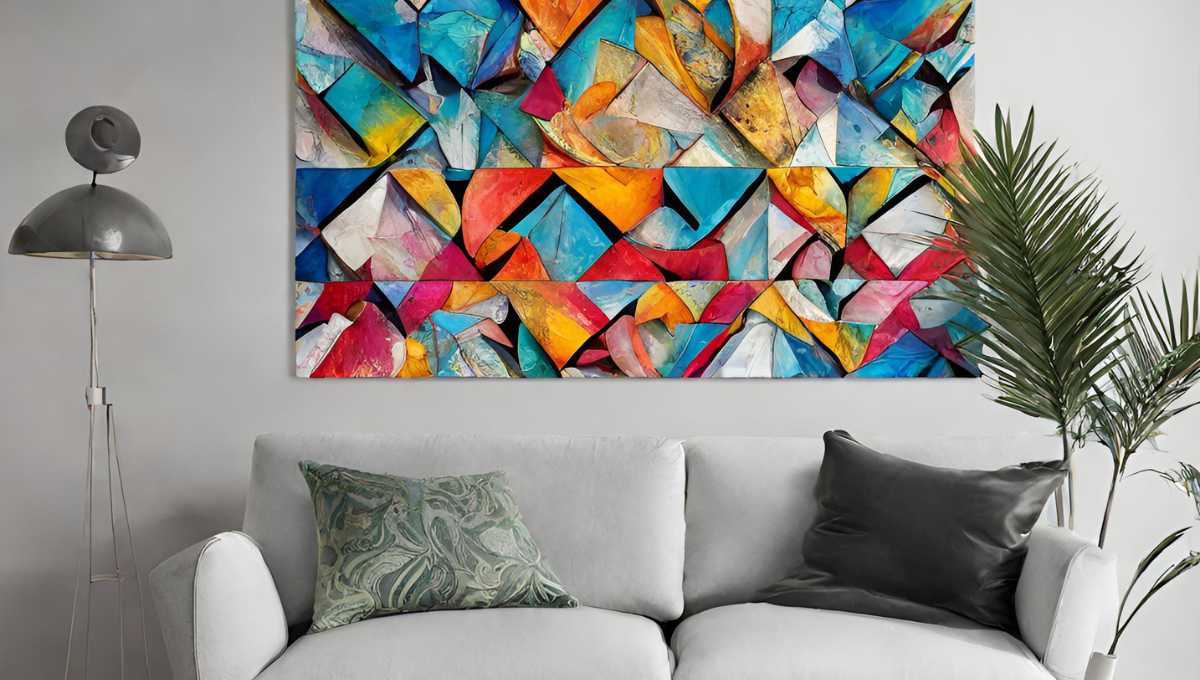
I wanted to create a faux watercolor abstract landscape.
That was a lot of words, but I am pulling inspiration from these images right here. These are high-end art pieces that are, of course, done by an artist or a print from an artist, but I think this is easily replicable. I think it’s something I’ve always wanted to try. So in front of me, I have my watercolor paper, and I have worked with watercolor on the channel before, but I wanted to do something that’s maybe a little more accessible if you don’t have watercolors in your craft supply stash, and that is just using some acrylic paints. I’m pretty certain this is going to work out, and I am going to just walk you through the process of creating a super simple, abstract-looking landscape.
Starting the second wall art project step by step
At first
- I started by drawing the horizon line on my watercolor paper, which is two-thirds down from the top.
- And to make the sky, I first wet the watercolor paper with just plain water and started adding in a very pale off-white tone that’s a little gray, a little beige, to create the look of a sky with some clouds.
- I just wanted to create a very pale sky that almost wasn’t there or wasn’t that noticeable.
- I wanted to create sort of a beachy scene with this, and what I did was take that paint, really diluted it with the water, and then just kind of started brushing it onto the paper until I got the look that I wanted.
- And I also layered it in areas where it got a little bit darker to create the illusion of depth in the scene that we’re creating.
And then I am goin to do
- Now you definitely kind of jump around a little bit with watercolors or faux watercolors, as we’re doing here. So for the water on this beach scene, I did the same thing I did for the sky, which was to first wet the water area before going in with a watered-down gray tone.
Now here you can see me mixing up a kind of terra cotta brown type color.
- However, I didn’t realize I was rolling on this portion, so I stopped rolling and then rolled again, and I already had the mountains painted, but I painted these just like the really faint ones in the background.
The final detail on this piece
- Instead of going in with the faux watercolor look, I’m just going in straight with this kind of medium-darkish gray tone and painting a little line right here to create the foreground mountain line or something like this, but I didn’t want this part to be watered down; I wanted it to be the straight acrylic paint right onto the paper.
- Now my favorite part of this watercolor pad specifically is that it is tacked down onto the pad; then you have to remove it like so. And it’s just great because then you don’t have to worry about stretching the paper.I got it back in high school to create a decal edge around the edge on all four sides, which is basically like a faux-torn look. But if you wanted to recreate this, you could obviously just rip the paper very carefully around the entire edge, and it would create the same sort of look.
And finally
It’s time to bring everything back together.Now, because my frame is a little bit larger than my art piece here, I’m using some duck cloth canvas to create the mat or the backing. You could obviously use a traditional mat for this if your frame comes with one. But first, I laid down my watercolor piece. I stuck a couple of little adhesive things onto the back of it to hold it in place once I put down the fabric. Then I added all the rest of the inner frame pieces and hung them up on the wall.
I absolutely love how all three of these pieces turned out. I just think they could be so versatile for any sort of space with any color or style that you want to do. And if you want to see even more wall art ideas, I suggest you check out this video right here. Or you can check out the one underneath it if you want to watch something else.
FAQ
Mistakes are part of the creative process. If you make a mistake, don’t worry! Acrylic paint can be painted over once it dries. You can also incorporate the mistake into your design—sometimes, unexpected elements can add character to your art.
Consider the color scheme and style of your room when choosing colors and designs. You can even bring in small samples of your room’s colors to the store when buying paints to ensure they match.
Absolutely! These projects are great for kids, especially the geometric wall art. Just make sure to supervise them, especially when using sharp tools or working with paint.
The time required depends on the complexity of your design and the drying time for the paint. Generally, you can complete these projects in a day, but it’s best to spread them over a couple of days to allow for drying between layers.
ther easy DIY wall art ideas include string art, photo collages, and framed fabric swatches. The possibilities are endless, so let your imagination guide you!

